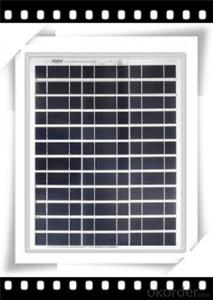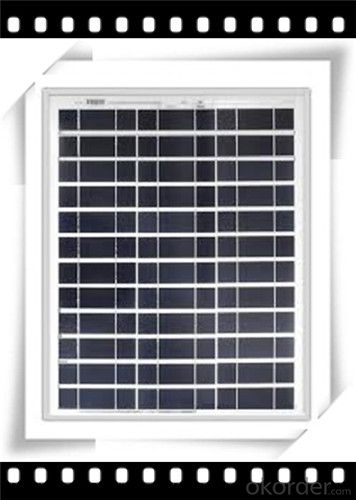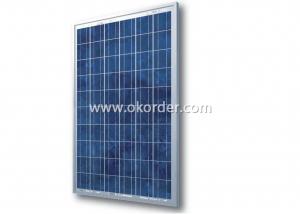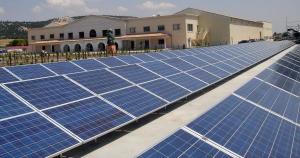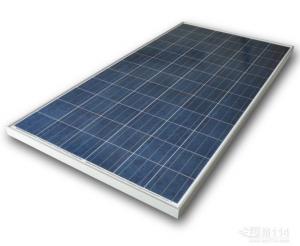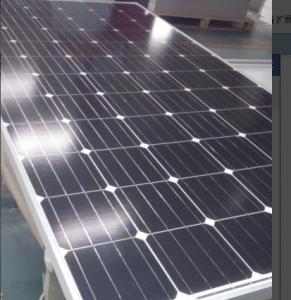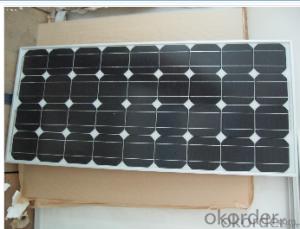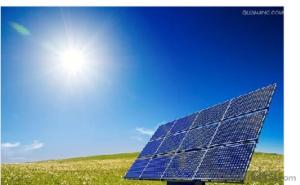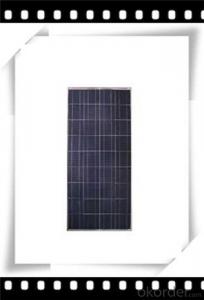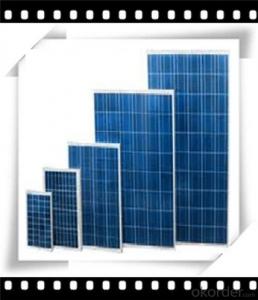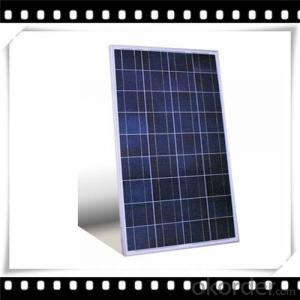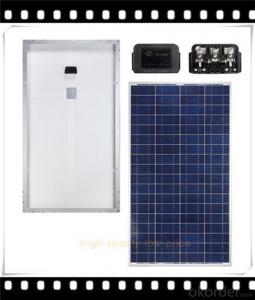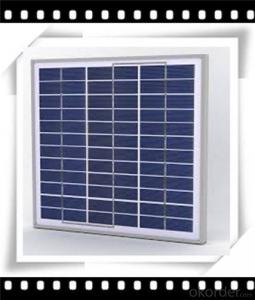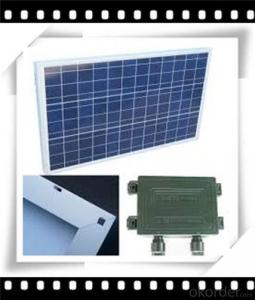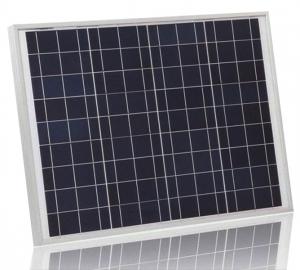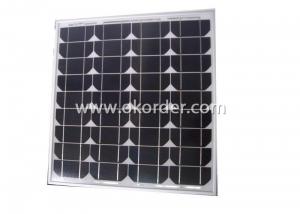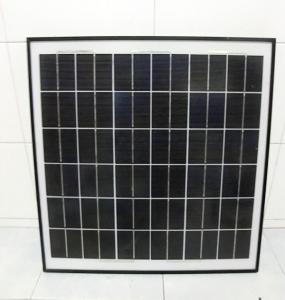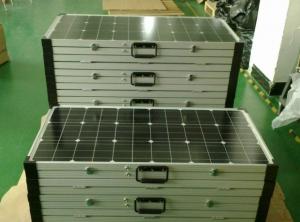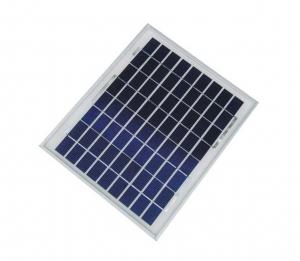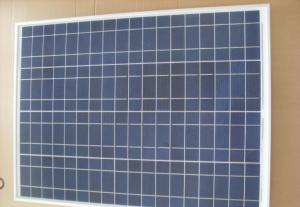0.45w Poly Solar Panel Mini Solar Panel Newest Solar Panel CNBM - Price of Solar Panels
- Loading Port:
- Qingdao
- Payment Terms:
- TT OR LC
- Min Order Qty:
- 10 set
- Supply Capability:
- 300000 set/month
OKorder Service Pledge
OKorder Financial Service
You Might Also Like
Polycrystalline Solar Modules
CNBM offers a range of small, medium and large polycrystalline solar modules, designed for a range of requirements.
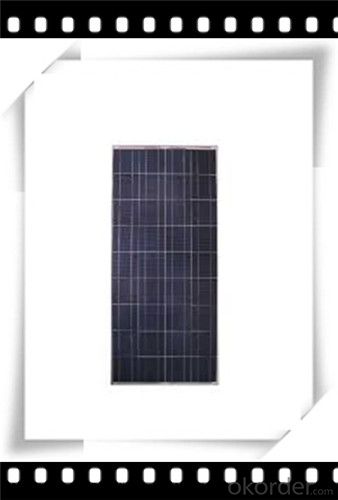
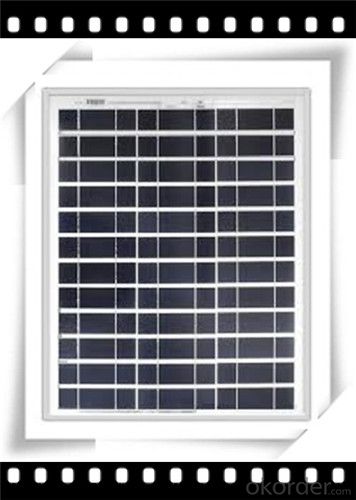
Specifications:
+/-3% |
Polycrystalline silicon solar cells (156 x 156mm) |
60 (10 x 6) |
1650 x 990 x 40 |
25.5 |
Limits:
Operating Temperature | -40~+85? |
Storage Temperature | -40~+85? |
Maximum System Voltage | 1000 VDC max. |
Hail Impact | Diameter of 28mm with impact speed |
Temperature and Coefficients:
NOCT | 48C+/-2? |
Voltage temperature coefficient (%/K) | -0.35 |
Current temperature coefficient (%/K) | 0.05 |
Power temperature coefficient (%/K) | -0.45 |
Characteristics:
Model: | SGM-200P | SGM-210P | SGM-220P |
Max-power voltage Vmp (V) | 29.2 | 29.4 | 29.41 |
Max-power current Imp (A) | 6.85 | 7.14 | 7.48 |
Open-circuit voltage Voc (V) | 36.5 | 36.69 | 36.9 |
Short-Circuit Current Isc (A) | 7.28 | 7.6 | 7.93 |
Max-power Pm(W) | 200 | 210 | 220 |
Model: | SGM-230P |
Max-power voltage Vmp (V) | 29.8 |
Max-power current Imp (A) | 7.72 |
Open-circuit voltage Voc (V) | 37.31 |
Short-Circuit Current Isc (A) | 8.19 |
Max-power Pm(W) | 230 |
STC: Irradiance 1000W/m2, module temperature 25?, AM-=1.5
Poly Crystalline Solar Panels Specifications Range
Maximum Power (Pm) | Dimension | Weight | Operating Voltage (Vmp) | Operating Current (Imp) | Open Circuit Voltage (Voc) | Short Circuit Current (Isc) |
0.45W | 140x80x10mm | 0.08kg | 3.3V | 150mA | 4.6V | 160mA |
1.0W | 162x140x10mm | 0.16kg | 7.5V | 150mA | 10.3V | 160mA |
4.5W | 269x251x23mm | 0.8kg | 16.5V | 0.27A | 20.5V | 0.3A |
10W | 420.1×268.9×22.6mm | 1.92kg | 17.5V | 0.58A | 20.5V | 0.6A |
20W | 425x502x50mm | 3.0kg | 16.8V | 1.19A | 21.0V | 1.29A |
30W | 593x502x22.6mm | 3.9kg | 16.8V | 1.78A | 21.0V | 1.94A |
40W | 655x537x50mm | 5.75kg | 17.3V | 2.31A | 22.1V | 2.54A |
50W | 839x537x50mm | 6.0kg | 17.5V | 2.9A | 21.8V | 3.17A |
65W | 1111x502x50mm | 7.2kg | 17.6V | 3.69A | 22.1V | 3.99A |
80W | 1204x537x50mm | 7.7kg | 17.6V | 4.55A | 22.1V | 4.8A |
- Q: how much would you pay for a 2'x4' solar panel that puts out 24 volts and 74 watts?
- Build okorder /
- Q: What is the biggest solar panel you can buy?How much energy can it produce in kwh?Thanks :)
- Depends upon the technology, but keep in mind that biggest may produce the most output per panel but smaller panels may have a higher efficiency factor and so produce more per sq meter. Solar Integrated Technologies:SI-G 864 - STC 864W Thin Film Roofing Membrane - PTC 779.8 Watts ENN Solar Energy: EST-480 - STC 480W Thin Film Tandem Junction Module - PTC 440.6 Watts SunPower:SPR-445J-WHT-D - STC 445W Monocrystalline Module - PTC 42.7 Watts Topsun: TS-M420JA - STC 420W Polycrystalline Module - PTC 376.3 Watts
- Q: I'm building a solar panel for the first time and have the tabbed solar cells. I put together 4 strings of 9 cells. And the cells are each 0.55V, 3.6A.Because I'm going to be using the panel indoors and leaning it up against a window pane, I put them in a 24x36 inch poster-size frame. The frame has a plexiglass cover and a thick cardboard backing. My question to you is this. Will the cardboard backing up against the metal underside (positive side) of the solar cells be ok? I don't know if it may catch fire or if holes may burn through when there's full sun.My guess here is it should be ok. But maybe I'm wrong. If I am wrong, or if something should be put in between, please let me know what I should use.Thanks everyone!
- In commercial panels some sort of polymer is often used for backing. With a 2V panel there are 36 cells, which means they can still output about 4V for charging a 2V battery even when hot. The voltage reduces about 2.2mV per degree C per cell. Commercial panels are meant to work up to about 60 degrees C, which is quite normal in the sun. I have found just lying them on the grass the air circulation is reduced, and they get too hot to charge a 2V battery. This means the backing should have good thermal conductivity while being an electrical insulator, as well as mechanical strength. The cells are often encapsulated in a thermosetting plastic first, then laid face down so a liquid polymer can be poured as backing.. I have removed commercial panels from their frames and re-packaged them to work in a very wet environment. I suppose cardboard would work, but it is unlikely to have good cooling so the expected voltage would be lower. As you intend to only operate indoors I suppose it is unlikely you have full sun most of the time anyway, so there could be less heating and less output current accordingly. I think the cardboard is only useful for a short time, and is not strong enough. Temperature wise it is marginal. The link below uses plywood for the backing. The backing is supposed to provide strength too. A sheet of some sort of plastic or laminate (including melamine laminate as in kitchen bench tops) comes to mind too. The cells are supposed to be bonded to the backing for better thermal conductivity. Use silicon RTV to stick cells to the backing, very thinly.
- Q: Can solar panels be installed on a flat roof?
- Yes, solar panels can be installed on a flat roof. However, it is important to consider the orientation, tilt, and shading of the roof to ensure maximum efficiency and productivity of the solar panels.
- Q: Hi, I bought 50 6X6 inch solar cells, I also bought a 40 amp diode, I still need to buy a battery, and inverter and a voltage controller, could you tell answer me the following questions:) I would like t build a small panel at first, (may be 0 X 0 inch), with that I would like (or at least to try) to power my laptop for the hole day, so I wont receive a very high amperage, yet, all the inverters I saw at e-bay are rated over 400 amp, if I buy a 400 amp inverter, can I use it with such a small amperage?2) what about buying a small car inverter, will it work?3) suggestion about the battery and the voltage controller will be kindly appreciated.Thanks
- I'm guessing that each of those solar cells is just 0.5 volt at max power, so if you make a 2-inch square panel, you will get 2 volts - not enough for the inverter. A car inverter is notoriously inefficient, but it would work if you connect it to a 2-volt battery. You cannot generally connect such an inverter to solar panels alone. The battery supplies the peak current that the inverter needs, and the panel charges the battery. To charge a 2-volt battery, you will want 36 cells, generally, which give you an 8-volt panel. You can buy an inexpensive charge controller somewhere. If your laptop will run off 2 volts directly, you can skip the inverter and be much more efficient. Or if the laptop runs of (say) 9 volts, you can use about 40 cells to get 20 volts, get the proper power plug from Radio Shack, and plug the panel directly into the laptop.
- Q: How do solar panels impact the local economy?
- Solar panels can have a positive impact on the local economy in several ways. Firstly, the installation and maintenance of solar panels create job opportunities, stimulating employment and income generation within the community. Additionally, the use of solar energy reduces reliance on imported fossil fuels, contributing to energy independence and reducing energy costs for both households and businesses. This can lead to increased disposable income, which can be reinvested in the local economy, supporting local businesses and promoting economic growth. Moreover, solar panels attract investment and contribute to the development of a clean energy sector, positioning the community as a hub for renewable energy innovations and attracting more businesses and investments in the long run.
- Q: Can solar panels be used in areas with high levels of radiofrequency interference?
- Yes, solar panels can be used in areas with high levels of radiofrequency interference. However, it is important to note that radiofrequency interference may affect the performance of solar panels and reduce their efficiency. Proper shielding and grounding techniques can be employed to minimize the impact of radiofrequency interference on solar panel operations.
- Q: I am looking at a need of roughly 30w/hour need per 24 hour period. I have spent several hours now looking for information online and have found plenty of info regarding the panels themselves, but information regarding the batteries backups have been slim. I understand that there is a 5-7 hour peak time to collect the energy. I am looking for information regarding the batteries themselves. How do the batteries work, what size batteries should I look for, and what is the life expectency for the batteries? Any website links would also be appreciated!
- Solar panels have their own characteristics and generate current depending on the intensity of sunlight falling on them and not on the temperature. Direction of the panel also makes lots of difference. Nowadays very thin panels are available at very high cost. The more area a panel occupies it generates more current. The current generated by a panel cannot be readily used since the current and voltage varies with the load connected to it. So normally a regulator is used to have constant voltage and constant current to come from the panel. This charges the battery. You have to calculate the total/normal current from the charger and then find the AH of the battery. When you have calculated the AH of the panel/charger then you can divide the AH of the battery by the AH of the charger/panel and find out the time taken to fully charge the battery. You also have to remember that there is a de-rating factor to be taken into consideration in the battery.
- Q: How do solar panels affect the environment?
- Solar panels have a positive impact on the environment as they produce clean and renewable energy, reducing the need for fossil fuels. They help decrease greenhouse gas emissions, air pollution, and water usage associated with traditional energy sources. However, the production and disposal of solar panels can have some environmental impact, including the use of certain materials and energy during manufacturing. Overall, their benefits outweigh the potential drawbacks.
- Q: Im doing a science project and I need to know what gases or liquids a solar panel can make that is not friendly to the environment. Please name all the gases and liquids and explain how they damage the environment. It would be most likely that you will get best answer if you find all the bad things about solar energy and explain why they are bad and how they affect nature. that would be helpful to. Thank you
- Radition
Send your message to us
0.45w Poly Solar Panel Mini Solar Panel Newest Solar Panel CNBM - Price of Solar Panels
- Loading Port:
- Qingdao
- Payment Terms:
- TT OR LC
- Min Order Qty:
- 10 set
- Supply Capability:
- 300000 set/month
OKorder Service Pledge
OKorder Financial Service
Similar products
Hot products
Hot Searches
Related keywords
